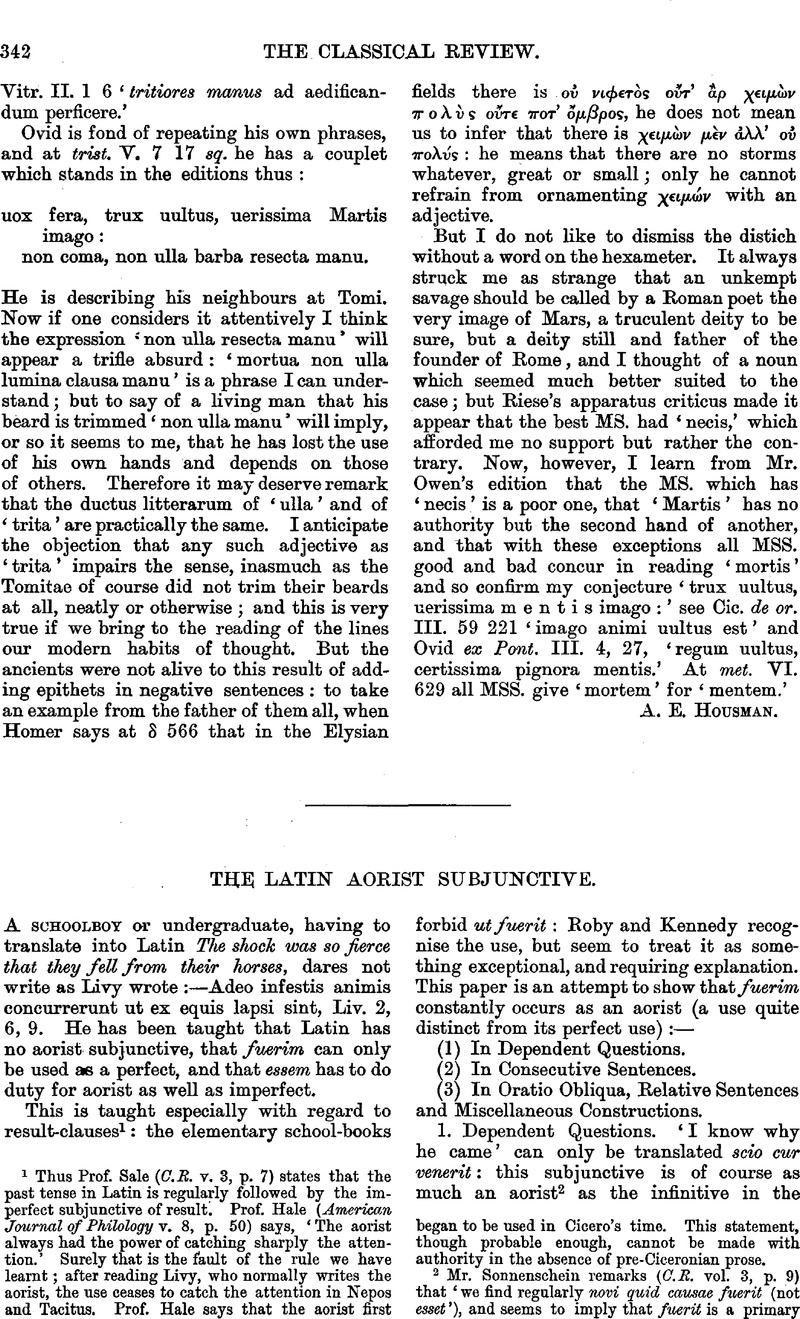No CrossRef data available.
Article contents
The Latin Aorist Subjunctive
Published online by Cambridge University Press: 27 October 2009
Abstract

- Type
- Review Article
- Information
- Copyright
- Copyright © The Classical Association 1890
References
page 342 note 1 Thus Prof. Sale (C. R. v. 3, p. 7) states that the past tense in Latin is regularly followed by the imperfect subjunctive of result. Prof. Hale (American Journal of Philology v. 8, p. 50) says, ‘The aorist always had the power of catching sharply the attention.’ Surely that is the fault of the rule we have learnt; after reading Livy, who normally writes the aorist, the use ceases to catch the attention in Nepos and Tacitus. Prof. Hale says that the aorist first began to be used in Cicero's time. This statement, though probable enough, cannot be made with authority in the absence of pre-Ciceronian prose.
page 342 note 2 Mr. Sonnenschein remarks (C.R. vol. 3, p. 9) that ‘we find regularly novi quid causae fuerit (not esset’), and seems to imply that fuerit is a primary tense, connected with the primary novi. The aorist is probably preferred as being clearer than the imperfect, but would not nescio quid faceret ? be Latin—I know not what he was doing ? The sequence of tenses can no more apply to dependent questions than to dependent statements; both are practically quoted sentences.
page 343 note 1 Here are some references:—
Cic. Phil. 1, 8; 1, 36; 10, 14; Tusc. 1, 100.
Caes. B.G. 1, 11; 3, 15; 5, 15; 5, 54; 7, 17.
Liv. Bk. 22:—5, 8; 32, 3; 37, 2; 40, 9; 42, 2; 45, 4; 56, 4; 61, 9.
Vell. Pat. 1, 9, 1.
Nepos Att. 1, 4; 2, 4; 5, 1; 6, 4; 7, 3; 9, 4; 10, 3; 12, 2.
Tac. Ann. 1, 80; 2, 30; 2, 55; 2, 81.
It is useless to reckon the instances of the imperfect; it will naturally occur much more often, having to express (1) limited statement of the expected result; (2) continuous, repeated or unfinished action, Even so, Nepos has ut esset forty-two times, ut fuerit forty-one times.
page 343 note 2 Roby's example factum est ut. is unfortunate, since the imperfect is of course used after such phrases (except in Nep. Milt. 5, 1—factum est ut voluerit).
page 343 note 3 Madvig reads converterint, which would dispose of the distinction drawn.
page 343 note 4 Mr. J. E. King (on Cic. Phil. 1, 8) falls back on the ‘more vivid’ explanation. Elsewhere (ibid. 1,36) he boldly translates the aorist as a perfect.
This exaggerated idea of distinctness leads to diversity. Mr. Moberly directly contradicts Eoby's explanation of indefinite time and non-contemporary result. He says, ‘The perfect lays more stress on the fact as occurring at a given time’ (n. on B.G. 3, 15) and again, ‘Caesar prefers the perfect when the consequence is instantaneous’ (n. on B.C. 2, 44).
page 344 note 1 Thisclumsy construction occurs in Livy three times independent questions, never, I think, in Tacitus: one may perhaps compare the vulgar English redundancy — I should have liked to have seen him.
page 344 note 2 I have ventured to write potential to describe the force of the apodosis (= Roby's hypothetical) without observing the illogical restriction of the word to cases where there is no protasis.




